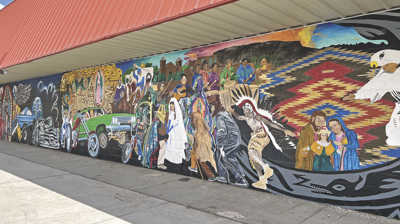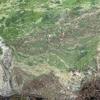A collaboration of artists, business owners, and community leaders came together to create two new murals in Española, which were dedicated to the community on Saturday, June 25th.
The murals, “Treasures of the Cultura” and “Sacred Earth, Caring Community” are located next to Cook’s Home Center, on N Paseo de Oñate. Each mural showcases a variety of factors that are unique to Northern New Mexico such as the traditions, agriculture, and geography.
The murals were funded by various organizations, including the City of Española; 100% New Mexico; Anna, Age Eight Institute; Revive Prevention Coalition; and Hands Across Cultures. The cost of the murals was not disclosed. Both murals are roughly twelve feet tall and fifty feet wide.
Hands Across Cultures Executive Director Diego Lopez said that through the collaboration of efforts, “We’re looking to create a positive movement, recognizing incredibly talented artists that we have in our community.”
“We live in a very unique and dynamic place that is rich in some of these traditions and heritage,” he said. “Each artist wanted to showcase that to the community to show how lucky we are to celebrate these kinds of traditions and keep the culture alive.”
Diego Lopez also added that the collaborators hope to create more murals throughout the city.
“We want this place to be covered in murals because it’s a drive for economic development,” he said. “We’re seeking to gather more momentum and collaborative projects.”
The artists, Cruz Lopez and Alejandro Lopez are local artists that have collectively created almost twenty murals throughout the community.
Cruz Lopez is the artist of “Treasures of the Cultura”, which is located on the wall in front of Cook’s Home Center on N Paseo de Oñate.
He said that he wanted to include important components of Española in his mural.
“I wanted to have things in my mural that the people from here would recognize and be proud of,” he said.
The mural, started in 2017, showcases images of religious and historical figures, Indigenous dancers, natural landmarks, a Rio Grande style weaving, meaningful architecture, and the unique rides that are often seen in Española.
Cruz Lopez explained that “Treasures of the Cultura” is located on the same wall as a different mural that was previously completed by another artist named Dino Martinez. Cruz Lopez wanted to make sure that both murals felt cohesive since they are located right next to one another.
“I wanted to keep that flow going with the things that we’re proud of,” he said.
In his mural, Lopez emphasized the mix of cultures and people that live in the area.
When asked about the inspiration behind the extravagant work of art, he said, “The mix of culture. Española is the melting pot of different cultures.”
In the portion of the mural where the Matachines, or traditional religious dancers are dancing, there is an image of a young girl dressed in white, right in the center. Cruz Lopez explained that the girl, “La Malinche” is a symbol of purity in the dance.
“She’s the central point, the purity and everyone is around her,” he said.
There are multiple images of the Virgin Mary, or Our Lady of Guadalupe in the mural. She is seen right in front of the Aztec calendar as well as on the attire worn by one of the Matachines.
“Our Lady of Guadalupe is a strong symbol here in New Mexico and Mexico,” he said.
Cruz Lopez also included a Native American Eagle dancer and drummers, with the Black Mesa and Santa Clara Pueblo.
He said that the Black Mesa is sacred and that, “When people take pictures of it, its like a landmark.”
To the right of the Black Mesa image is a weaving pattern of a Rio Grande design. Lopez explained that for him, weaving is an important artistic tradition.
“When we were little, my parents tried to teach us these artistic traditions to keep the traditions going,” he said.
The mural also showcases an image of a Sikh temple and the Holy Cross Catholic Church to show the diversity of religions in the area.
Lopez said that the Sikh temple is “one of the important Sikh strongholds in the United States”.
The far left images in “Treasures of the Cultura” show people riding in a lowrider, a motorcycle, and a bicycle as a reference to the unique transportation that is found in Española.
The end piece of the mural shows a design of pottery with a water serpent image, which is a symbol of protection.
“People tell me there’s a lot of protection in that painting because of all the elements in it,” he said.
Lopez said that he is grateful for the community response that he has received from the mural.
“People come up and talk to me and tell me how much they enjoy it, I’ve gotten to know people from around here and out of state.” “They honk when passing by, they bring me food, they take pictures, and park their low-riders in front of it,” he said.
Cruz Lopez also said that the goal is to create community awareness through his murals.
“We’re trying to use those murals to create community awareness,” he said.
Although the mural has received positive attention from the community, Lopez stated that it can be challenging to receive funding for projects such as this one.
“The hard part is to get funding,” he said. “The mural is helping bring my name out, I’m super happy about that, hopefully we receive more funding to make more around Española.”
Cruz Lopez has also completed seven other murals in Española, some of which bring awareness to important issues in the community. “Darren’s Place” located behind Food King is a tribute to people that have suffered from substance abuse.
Alejandro Lopez is the artist of “Sacred Earth, Caring Community”, which is located in the alleyway between Cook’s Home Center and the abandoned building that was previously a bank. He has also completed ten other murals throughout Española, some of them in collaboration with other artists.
“Sacred Earth, Caring Community” showcases the geography, agriculture, religion, people, and culture of Northern New Mexico.
The mural “celebrates geography and also celebrates a community of people who historically have had a very direct and close contact with the Earth, with one another, and with their work,” said Alejandro Lopez.
His inspiration for “Sacred Earth, Caring Community” came from the geography that is found in Northern New Mexico.
When asked about the inspiration behind the mural, he said, “The spectacular quality of the geography in Española.” He also added that he wanted to showcase “the geography, how we are surrounded by magnificent mountains, mountains that harbor snow and collect water.”
The mural includes a variety of people taking on different tasks within their community. It shows a river running through the middle, with people on both sides of it, some irrigating their crops and others caring for children.
Alejandro Lopez stated that he wanted to show the different stages of life in the mural by including children, youth, adults, and the elderly.
“It is a procession of life,” he said. “Your eye is asked to move from one extreme, one end of the mural to the other, and you see a procession of life. It is also a prayer for rain and abundant snowfall, much of it was painted during the fires of Mora and Las Vegas.”
“The multitude of intergenerational people in the composition conjure thoughts of a loving and caring family tribe of community. I believe that it is possible to live in harmony with each other and to be a caring and responsible people toward the Earth and with one another” he said.
The mural has been a work in progress for two months and will require some additional time until it is complete.
“It has been both daunting and exhilarating,” he said. “The scale is enormous and requires extreme physical exertion. Sometimes the weather has been oppositional.”
Although the mural has been a challenge, Alejandro Lopez said that the community’s response to it has been satisfying to experience.
“The occasional passerby mostly cheered me on,” he said. “People who rarely have a word to exchange with a stranger would almost always compliment the work, there were some that wanted to discuss it, most had a very positive emotional response.”
“The response for the dedication on the 25th was substantial from the community,” he said.



(0) comments
Welcome to the discussion.
Log In